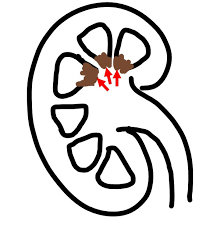How does diabetes damage the kidneys (5 ways)?
Kidney disease occurs in patients with both type 1 and type 2 diabetes mellitus, usually after at least 10 years of the disease. Diabetes can affect the kidneys in five ways:
- Diabetic nephropathy
- Renovascular disease
- Urinary tract infection
- Papillary necrosis
- Other kidney conditions.
We will now go through how does diabetes damage the kidneys (5 ways).
1. Diabetic nephropathy (DN)
Diabetic nephropathy is primarily a glomerular disease, i.e. it damages the glomeruli of the kidneys.
40% of patients with DM develop some degree of DN. It shows itself as persistent protein in the urine (especially albumin; which is then called ‘albuminuria’), and later. progressive CKD. There is substantial evidence that early treatment – with tablets called ACE/ARBs and SGLT2is – can delay or prevent the progression of the disorder.

This is a glomerulus (tiny filtering unit) in a kidney biopsy. The pink lumps in the upper right area are called ‘Kimmelstiel-Wilson nodules’, which are typical of diabetic nephropathy.
Doctors call DN a ‘microvascular disease’. This means if affects the smaller blood vessels (including arterioles and the glomeruli) in the kidneys. How diabetes causes DN is not exactly known. But high blood pressure (hypertension) is thought to play a key role.
“This is why it is so important to have lower blood pressure (ideally 120/70 or below) if you have diabetes.”
Note 1. Diabetic nephropathy is the most common cause of nephrotic syndrome in adults
Note 2. DN is strongly linked to diabetic retinopathy. In fact if the patient does not have eye disease, you should look for other (non-diabetic) causes of the patients CKD. This may include a renal (kidney) biopsy. Diabetic eye disease is another microvascular disease in diabetes.
2. Renovascular disease (RVD)
Renovascular disease (RVD) – or renal artery stenosis – means a narrowing of the artery to one or both kidneys. It shows itself as progressive CKD or very high blood pressure that is hard to control. It is especially common in older patients with diabetes who have smoked. Typically the patient has normal (or low) levels of protein (especially albumin) in the urine.

Typical renal (kidney) angiogram (xray) of (one-sided) renovascular disease – showing a stenosis (tightening) of the left renal artery, and a (normal) ‘double artery’ to the right kidney. Such variants are common.
It is a similar disease to ischaemic heart disease (IHD; that causes angina and heart attacks), cerebrovascular disease (CVD; strokes) and peripheral vascular disease (PVD; whch can cause gangrene of the toes or feet). In fact most patients with diabetes and RVD will have evidence of one or more of these diagnoses as well.
Doctors call RVD a ‘macrovascular disease’. These means it affects the large blood vessels (arteries) that supply blood to the kidneys.
Note. Many patients with type 2 diabetes have a combination of DN and RVD. It can be hard for doctors to tell which you have and if you have both, which is more of a problem.
3. Urinary tract infection
Diabetes affects the immune system, making infection more likely generally. This includes infection of the urinary tract, including these types:
4. Papillary necrosis (PN)
Diabetic papillary necrosis (PN) is a rare complication of diabetes mellitus that affects the kidneys. This condition involves the death (necrosis) of the renal papillae, which are small, nipple-like structures in the inner part of the kidney.

Papillary necrosis. A papillus (or part of) can break off. It can then be misdiagnosed as a kidney stone.
The symptoms of diabetic papillary necrosis vary but include:
- Blood in the urine (haematuria)
- Flank or lower back pain
- Frequent urinary tract infections (UTIs).
Note 1. Papillary does not usually cause CKD
Note 2. There are other causes of papillary necrosis including NSAID painkillers (called ‘analgesic nephropathy’) and sickle cell disease.
5. Other kidney conditions
- Type IV Renal tubular acidosis (RTA). This is rare kidney disease, but not so rare in moderate-advanced diabetic kidney disease. It shows itself by having an unexplained high potassium level in the blood, after drugs that are known to cause a high potassium (e.g. ACE/ARB/spironolactone) have been stopped
- Hypertension. Diabetes also causes high blood that contributes to 1 and 2.
Mnemonic
A mnemonic called ‘DRIPO’ will help you remember the 5 ways diabetes can affect the kidneys.
D – Diabetic nephropathy
R – Renovascular disease
I – Infection
P – Papillary necrosis
O – Other.
Summary
We have described how does diabetes damage the kidneys (5 ways). We hope it has been helpful.
‘Diabetic kidney disease (DKD)’?
When diabetes affects the kidneys some doctors call it ‘diabetic kidney diseases (DKD)’. CKDEx prefers not to use that phrase as it means you have not looked carefully enough which of the five above is the cause of the problem. It is often a combination.
[“That has told ’em.” CKDEx Ed]
Last Reviewed on 22 November 2023
